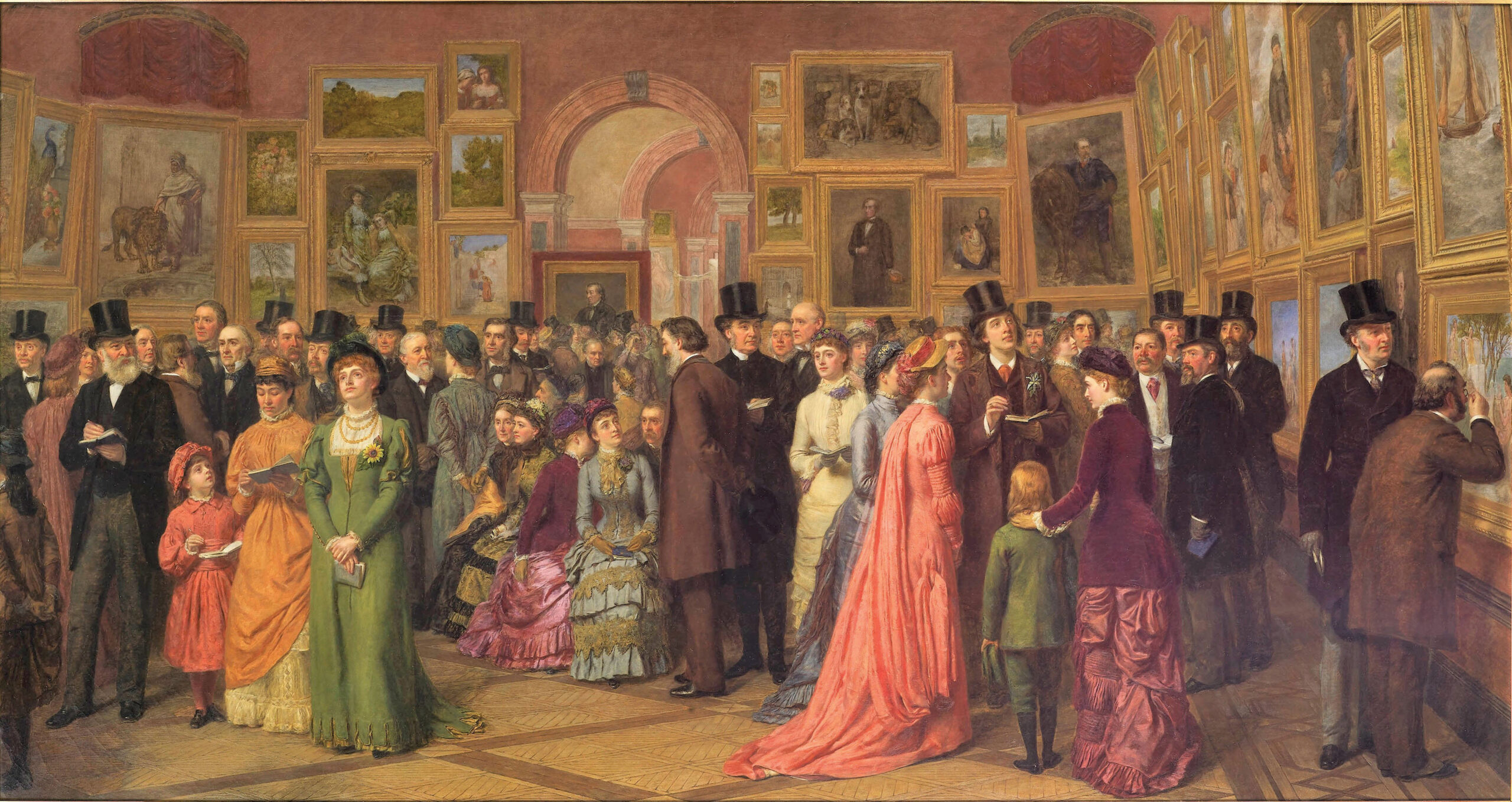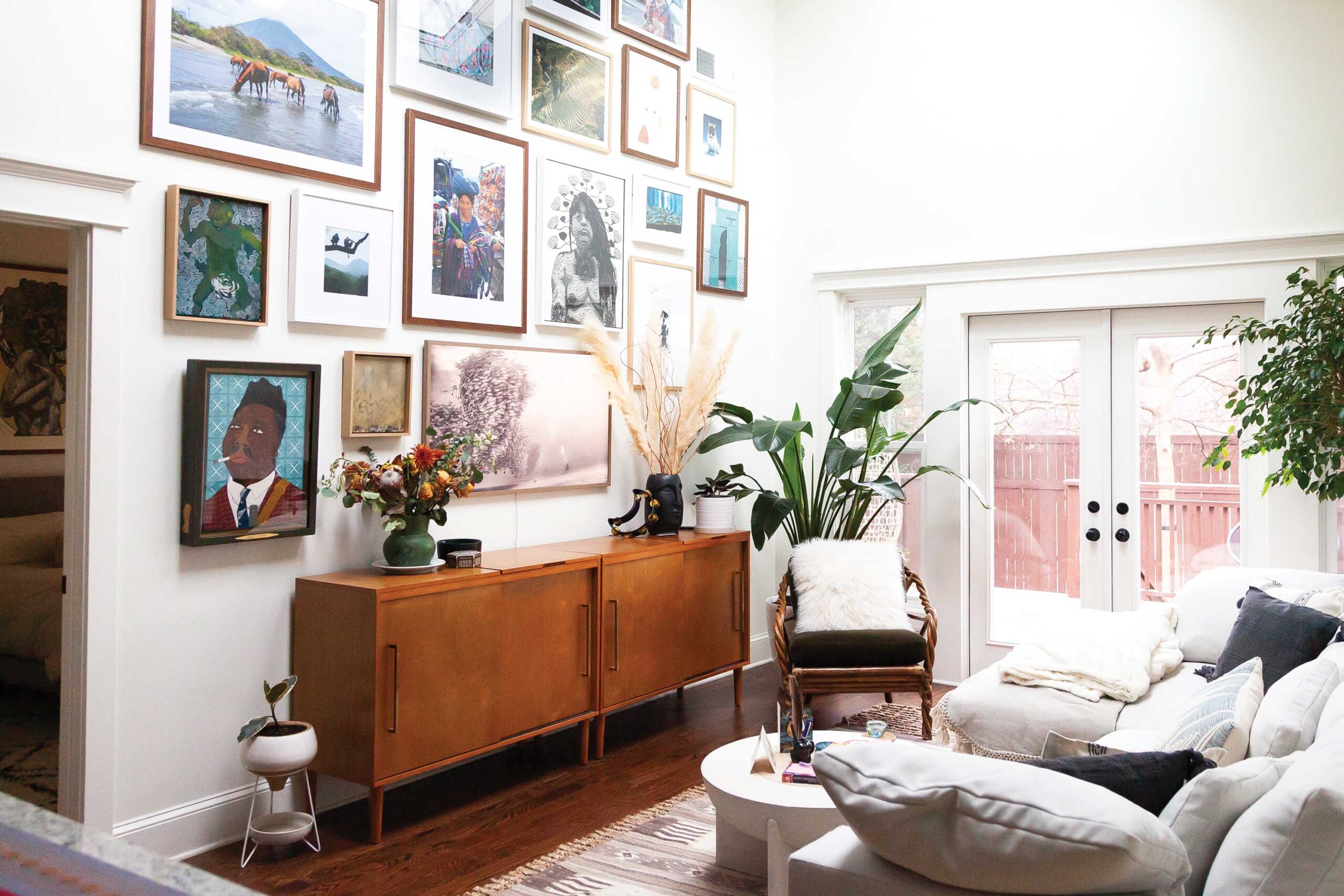By Jane Barton
The phrase “staring at my four walls” gained a whole new meaning for most of us in 2020. Many people were spending more time at home, especially if they had the advantage of being able to work remotely. What we wanted to see every day (then and now) and — in a world of constant Zoom meetings — what we want others to see behind us, feels increasingly important.
Whether you’re a serious collector with more art than you can ever hope to display, an appreciator with a small group of pieces you’ve collected with love, or a remote worker who just wants something beyond the ubiquitous bookshelf background, please read on for a brief history of “gallery walls” and some advice from experts to help find your own gallery wall style.

An Evolution
What we now call gallery walls can be traced back centuries to the tradition of salon-style hangs. From the 17th century onward, the Paris Salon, a juried show at the Louvre featuring thousands of artworks, accepted way too many pieces, so its organizers literally filled the walls, with almost no regard for styles and subjects, in order to maximize the number that could be shown.
The most prestigious artists got their works hung at eye level (“on the line”), a perk that allowed their creations to be seen better and thus more likely purchased. Lesser-known painters were given whatever “real estate” remained: either very high up (“skied” because they were closer to the sky) or very close to the floor. Artists often relied on impressive frames to focus visitors’ attention and to distinguish their works from the others hanging all around them.
Crowded as its walls were, the Salon was also crowded with admirers, and soon its style of dense display took off internationally. For example, this approach was embraced by London’s Royal Academy of Arts, where William Powell Frith created the painting illustrated here showing a crowd of elite art lovers admiring the packed walls of the annual Summer Exhibition.
Today, exhibition organizers worldwide still use the salon (or gallery wall) style. Whichever term you use, this approach is alive and well, especially for plein air painting events when a lot of new works are produced all at once. Many collectors today have the same problem experienced in Paris long ago: lots of art and not enough wall space to hang it. This challenge can be tackled in different ways depending on the type of art you want to display.
Grid / Stacking
If you have a group of works by one artist, or a mix by multiple artists in the same genre, you can design your gallery wall in a grid layout with uniform frames, sizes, and colors. For extra impact, you can even hang the pictures so they continue around the corner of the wall or onto the next closest wall. James Huniford of New York City’s Huniford Design Studio says he has “always liked salon walls because they look more interesting and pique viewers’ curiosity.” Pointing to his two adjacent walls of prints by Henri Matisse (both walls are illustrated here), he explains, “I wanted to present Matisse’s Jazz series in a way that was modern and approachable, almost like an installation. The way I’ve stacked them was inspired by Donald Judd’s stacked boxes.”

Freeform
A more eclectic gallery wall can have an organic arrangement featuring a variety of original artworks, prints, photographs, and even objects. The common denominator for this approach is the collector, not the framing, coloring, medium, or imagery.
I created my own “freeform” gallery wall when I moved into a new home and wanted to surround myself with paintings I made and others’ paintings I love, objects from my travels, and good memories. I pulled more than 70 items out of moving boxes and storage, then started hanging them from the middle, radiating out. Only about 35 pieces made the first cut, but now I keep adding more over time so that the wall grows organically. The pieces don’t align in any way; they just fit together in a random puzzle style.
A key advantage to this approach is its ability to change from time to time — it is truly a living, fluid thing. I am fortunate that I can regularly hire a local handyman with a very tall ladder and lots of patience. I call him when I’m ready to add another row or to replace some pieces. As soon as they arrive, visitors to my home immediately begin identifying their favorites, asking questions, and (ideally) commenting on the artworks. Since this approach isn’t precious, it is easy to take some risks, like adding an old license plate from a favorite vehicle. The wall’s content can include anything that tells your story.
A successful gallery wall inspires viewers’ curiosity, sometimes in unexpected ways. Recently my daughter uploaded to her dating app profile a photo of herself standing before my gallery wall. She was really surprised by what a great icebreaker it proved to be. When potential dates reached out to chat, they often started by asking about the wall. They seemed genuinely curious about its artworks and even requested tips on how to hang their own collections. My daughter feels her photo may have made it easier to engage because they had something unique to respond to. Moreover, it was easy for her to respond because she had grown up with many of those paintings.
Importantly, the pieces on your gallery wall also communicate with one another; the way they are arranged makes the eye bounce from one to another in surprisingly specific ways. Each work is viewed in relation to those near it, and the gallery wall as a whole communicates something personal, even insightful, about the collector.

Personal Branding
Emily Joffrion runs her own consultancy in Atlanta creating powerful brands for businesses and other organizations. When she injured her leg and was confined to a couch for weeks, she used that time to think about her own story as “told” on her gallery wall. Joffrion explains, “The act of being grounded, looking up at this wall, slowing down to really look at these experiences in my life, satisfied something inside that has been very hungry. I realized that it wasn’t hungry for more, it was hungry for depth of meaning.… By taking the time to reflect and surround myself with the things I care about, to curate my life experience, to curate my home, it’s an act of editing. Your life is a work of art.”
Ultimately, Joffrion sees walls as collectors’ brands, telling their stories. In planning your wall, we should ask, “What’s my message? What am I trying to communicate with my wall and in my space?”
Celebrating Themes & Paying Tribute
Misha West, a designer at Modern Nest in Scottsdale, created a gallery wall for a couple who had recently moved to Arizona from the East Coast and wanted an installation that would celebrate their new life in the Southwest. West used a subtle, limited palette that reflects the desert’s coloring and gathered photographs and prints that depict cacti, horses, mountains, and other subjects related to why her clients love this region. The theme of the resulting wall could readily be called “Pride of Place.”
Just last spring, I was commissioned to create 15 paintings for a gallery wall at Senna House, a new, upscale hotel in Scottsdale. The hotel is part of Hilton’s Curio Collection, which aims to make each of its properties feel unique and specific to its setting. Senna House stands on the former site of a legendary restaurant, Don & Charlie’s, which was renowned for both its ribs and its extensive collection of sports memorabilia. Tyler Kent, principal of Opwest Partners, the firm that developed the hotel, wanted to honor its heritage with a gallery wall of my paintings inspired by that memorabilia — including basketball jerseys, signed baseballs, and more — as well as by iconic Arizona landscapes and desert plants. Now my 15 new paintings fill a wall constructed of sleek wooden planks that evoke the vanished restaurant’s wood-paneled walls in a thoroughly modern way.
Though my artworks focus on specific themes, the design team — including framer Faye Urlacher of Art Studio 101 and designer Dala Al-Fuwaires of House of Form — chose a range of frames that would help each piece stand out while uniting all 15 within the hotel’s overall style (dubbed “authentic desert modern”). I think of the result as a “tribute wall,” something that works as a large narrative and a focal point. It sparks conversation among patrons, allowing them to stop and relate to the space in a memorable way, even as it honors the past. As in a home, personal touches in a hotel or other public-facing business can make all the difference between a venue that feels generic and somewhere you want to linger.

The Business of Gallery Walls
Feeling overwhelmed? Fortunately, the gallery wall phenomenon has given rise to businesses that do it all for you, acting as designer, curator, and framer. For example, Emily Joffrion hired Kate Byars, founder of Lo & Behold, who describes her work as a process of discovering and unearthing her client’s personal narrative. This can entail examining a 10-year backlog of items, culling and then choosing which pieces to display.
Byars cautions, “A wall is overdone if there is no editing at all. It’s underdone if there’s nothing personal. There is an art to framing and an art to creating the right scale. The wall should spark conversation.” She adds that sometimes clients don’t actually recognize their own story until the wall is hung. Then comes that “aha” moment — when the story unfolds about what and who matters to them.
Whether you’re contemplating a gallery wall for your home or your business, try to showcase your own passions. For instance, Dala Al-Fuwaires suggests that business owners who love to travel should reflect that interest, even if their business isn’t a travel agency. She encourages corporate clients to think of the gallery wall as an experience “mixing and matching pieces that were collected over time.” She says, “They work together because they are telling a story. The art can be funky, classic, modern … posters, original oils, masks, wooden plaques. Experiment, keep it fluid, and make substitutions as the collection evolves.” In this regard, Al-Fuwaires maintains that designers are often “experience managers” too.
Framing
Whatever you are trying to communicate on a gallery wall, framing choices help set the tone. Trends have changed over time, of course. At the Paris Salon, art was displayed in ornately carved gilt frames that generally resembled each other. Faye Urlacher encourages clients to try “coloring outside the lines” by mixing frame profiles and materials. Recently more clients have been saying they want to keep their existing artworks but update how they are displayed, so she selects new mats and frames to complement the clients’ new or renovated interiors. This can be considered a recycling project of sorts, giving new life to old art.

The Future of Gallery Walls
So, what’s the future of gallery walls? Maybe someday collectors will choose to safely store their artworks, photographs, and memorabilia in climate-controlled warehouses and just project rotating digital displays of those items on their walls at home. In that scenario, changing the displays will be as easy as pressing a button or uttering a voice command: “Alexa, I want the holiday gallery wall for my party tonight,” or, “Alexa, show my East Coast Zoom meeting wall this morning.” In fact, someday you might not even need to own the paintings projected; perhaps you will hear yourself telling Alexa, “My book club is coming tonight, so project a collection of Georgia O’Keeffe paintings.”
What’s on your gallery wall, if you have one at your home or office? If you don’t have one yet, what do you want your wall to say about you, your artistic preferences, or your space? What matters most is that — gridded or freeform, edited or excessive, themed or random — it feels just right for you. The choice is yours.
View more artist and collector profiles here at FineArtConnoisseur.com.









Thanks for the great article!
Our entire house is a gallery wall. We have so much original work of our own and others that there is no choice, but I love it that way. Some walls are freeform, some are a bit more structured. It really depends on the groupings and how it fits the area where they are hung.
Thank you for such great article. It validates the way I developed my free form gallery wall.